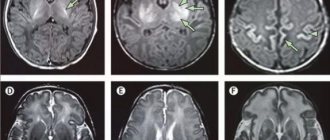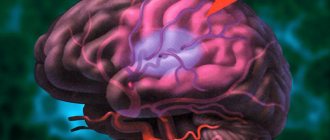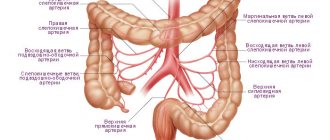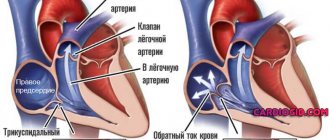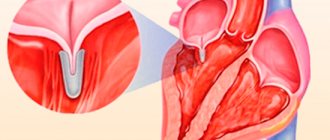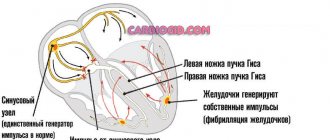The brain is the main organ in the body. The functioning of all organ systems, general condition and quality of life depend on its functioning. With the development of certain pathologies, the brain begins to suffer due to lack of oxygen, and this can lead to serious consequences. One of these diseases is grade 2 cerebral ischemia in newborns; the consequences can be disastrous if urgent measures are not taken and therapy is not started. Let's look at what this pathology is and whether it is possible to get rid of it.
Concept of cerebral ischemia
Not everyone understands the name of the disease as “cerebral ischemia of the 2nd degree in newborns.” The doctor can explain this and choose treatment tactics. This pathology is a condition in which the blood supply to the brain is disrupted. In newly born infants, this pathology, as an independent disease, is not often diagnosed.
Most often, newborns are diagnosed with “ischemic encephalopathy,” in which brain cells are damaged due to poor blood supply, that is, lack of oxygen.
If a diagnosis of “grade 2 cerebral ischemia in newborns” is made, how to treat this pathology is determined by the attending physician, depending on the condition of the body and concomitant diseases.
-th degree
In this case, there is an implicit appearance of neurological disorders. With grade 1 cerebral ischemia, patients note the appearance of:
- Headaches.
- General weakness, which gradually develops into severe fatigue.
- Decreased concentration.
- Frequent insomnia.
- Memory impairment.
- Emotional instability.
However, these symptoms are not specific. Because of this, it is very difficult to timely diagnose the appearance of grade 1 cerebral ischemia. Many people associate all these symptoms with overwork, so they rarely seek medical help. However, you need to understand that this stage of pathology is amenable to the fastest and most effective treatment.
Reasons for the development of ischemia
This pathology in newborns can develop for several reasons:
- If during gestation the placental blood flow was disrupted.
- After birth, respiratory distress was observed.
- Respiratory distress syndrome.
- Congenital pneumonia.
- Frequent episodes of respiratory arrest.
- Aspiration.
- Congenital malformations.
Whatever the reasons, grade 2 cerebral ischemia in a newborn can have serious consequences if therapy is not started in a timely manner.
Causes
In newborns, the pathology in question can be provoked by the following factors:
- During contractions and pushing, the umbilical cord is pinched, which affects the blood supply to the brain and other organs
- long labor
- placental abruption
- acute placental insufficiency
- asphyxia (suffocation) during childbirth
- intrauterine hypoxia
- prematurity, which causes respiratory failure in the baby
- patent ductus arteriosus
- disruption of blood flow to the heart
- congenital heart defects
- sepsis, which causes the child’s blood pressure to decrease
- heavy bleeding caused by various reasons
Development of pathology in a child
Oxygen is carried throughout the body along with blood. It is vital for the normal functioning of all organs. If there is a deficiency, a redistribution of blood flow occurs and the heart and brain receive oxygen-rich blood first. It turns out that other organ systems begin to suffer from its deficiency.
If the pathology is not identified in a timely manner and the causes that provoked it are not eliminated, then the lack of oxygen will gradually begin to negatively affect the condition of the nerve cells - they begin to die. This is how grade 2 cerebral ischemia develops in newborns, the consequences depend on the severity of the condition and the quick response of doctors. The prognosis for the baby will also depend on the number of dead cells. If a cerebral hemorrhage occurs, the chances of recovery and survival are significantly reduced.
Where does blood come from to the brain?
The main feeding vessels of the brain are two internal carotid arteries and two vertebral arteries. They receive blood from the aorta through intermediate large vessels: the brachiocephalic tract, the subclavian artery. Up to 85% of the required volume is delivered through the carotid arteries.
The vertebral arteries are protected by the bony canal of the transverse processes of the upper thoracic and cervical vertebrae. They provide nutrition to the base of the brain, the cerebellum and the posterior parts of the cortex. Connecting on both sides, they form a single unpaired vessel (main artery).
The blood supply inside the brain comes from two circles of Willis (circles of Willis and spinovertebral), located at the base of the skull. Both circles form the basins of the anterior, middle and posterior cerebral arteries symmetrically on both sides.
An important feature is the connection of small capillaries through anastomoses (shunts). This helps to avoid the phenomena of cerebral ischemia when there is insufficient blood flow in one of the arteries. The affected area begins to be supplied through a shunt from another vessel.
Provoking factors
Concomitant factors that can lead to the development of ischemia can be grouped into three groups:
- The course of labor. The risk of pathology increases if:
- bleeding occurred during pregnancy or during labor;
- emergency caesarean section;
- high temperature in a woman in labor;
- premature birth;
- low baby weight;
- turbidity of amniotic fluid;
- premature placental abruption;
- rapid labor activity.
2. The mother's condition can cause the development of ischemia in the child, especially when:
- the expectant mother suffers from neurological problems;
- there are pathologies in the functioning of the endocrine system;
- pregnancy at a later age;
- the presence of chronic pathologies in the mother.
3. The course of pregnancy is also very important: if preeclampsia or eclampsia was observed, then there is every chance of developing a pathology such as grade 2 cerebral ischemia in the newborn. The consequences may vary.
These factors are not a 100% guarantee of the development of pathology. Even intrauterine disorders do not always end with cerebral ischemia developing after birth; the consequences can be eliminated if the pathology is detected in time and all measures are taken.
Consequences and complications
The pathology is quite dangerous and is one of the most common causes of child mortality. How favorable the prognosis will be depends on the severity of the baby’s condition and the Apgar indicator. If the score increases, the prognosis is considered favorableSource: Modern methods of treating neonatal asphyxia. Cherednikova E.N., Sherstnev D.G. Bulletin of Medical Internet Conferences, 2021. p.824.
However, with severe pathology, serious complications develop during the first year of life. Early consequences that may appear in the first few days after resuscitation include :
- respiratory arrest (the most common and dangerous complication);
- pulse failure;
- convulsions;
- cerebral edema;
- disruption of the urinary and digestive systems.
Later disorders include the following diagnoses:
- syndrome of increased excitability (hyperexcitability);
- increased intracerebral pressure (hypertension syndrome);
- lesions of the central nervous system (perinatal encephalopathy);
- disruptions in the functioning of the endocrine and vegetative-vascular systems (hypothalamic disorders).
With timely and competent medical intervention, as well as a high-quality recovery period, asphyxia of newborns may not have dangerous consequences in the future. Mild forms of asphyxia have almost no effect on the child; after the illness, his further development will proceed in the same way as in other babies.
How does the disease manifest itself?
This pathology has varying degrees of manifestation. Stage 2 cerebral ischemia in newborns has serious symptoms, and immediate treatment is required. Here's what should alert doctors and mommy:
- Decreased muscle tone.
- Large pauses in breathing.
- Tendon reflexes are poor.
- Sluggish Moro reflexes.
The following syndromes are also noted:
- Syndrome of increased excitability, which manifests itself in crying for no reason, restless and superficial sleep, twitching.
- Hydrocephalic syndrome can be recognized by an increase in the size of the head and a large fontanel.
- Convulsive syndrome is present.
- If there is grade 2 cerebral ischemia in newborns, depression syndrome reduces sucking and swallowing reflexes, muscle tone is weakened, and strabismus may occur.
- The most serious syndrome is comatose. If it is present, the baby’s condition is serious, there are no reflexes, no reaction to external stimuli, low blood pressure, and breathing problems appear.
Signs and symptoms of cerebral ischemia in newborns
The disease manifests itself with obvious symptoms that attract attention.
- The child is easily excitable, cries for no reason, sleeps poorly, shudders, and has tremors.
- Muscle tone is reduced, the baby moves little, has difficulty sucking and swallowing.
- The fontanel is enlarged, intracranial pressure is increased due to the fact that fluid accumulates in the brain.
- Convulsions, twitching of the limbs and head, as well as comatose states with loss of coordination of movements and consciousness occur.
- The newborn's skin takes on a marbled hue.
- The functioning of the gastrointestinal tract is disrupted - bloating, constipation, and diarrhea are observed.
When lack of oxygen threatens the baby's life
If this pathology has grade 1, then it is considered a mild lesion, and doctors assess the condition of the newborn on the Apgar scale at 6-7 points. This degree is manifested by stimulation of the nervous system if the child was born at term, and depression in premature infants. This condition can be observed for 5-7 days.
Cerebral ischemia of the 2nd degree in newborns has more serious consequences; clinical convulsions, respiratory arrest, and floating movements of the arms may appear. If laboratory tests are performed, lesions of the brain parenchyma and disturbances in blood flow speed are detected.
If long periods of impaired motor activity, poor appetite, and impaired swallowing are observed, then an urgent consultation with a neurologist is necessary.
A severe degree can result in coma, which is life-threatening for the baby. Increasing symptoms increase the risk of developing hydrocephalus.
How is the disease diagnosed?
Almost always, the manifestation of cerebral ischemia begins immediately after childbirth. If the disease is mild, then the symptoms may go away on their own, but a severe form may slightly weaken its symptoms, but only for a while, and then flare up again with renewed vigor. Therefore, if ischemia is suspected, various diagnostic procedures should be carried out, these include:
- Examination of the child for the presence of reflexes and assessment of the condition using the Apgar scale.
- General blood analysis.
- MRI if moderate or severe is suspected. This study helps to examine the structures of the brain and determine the extent of their damage.
- Ultrasound - allows you to detect cerebral edema or an area of hemorrhage.
- An electroencephalogram is mandatory for newborns with severe disease.
If a diagnosis of grade 2 cerebral ischemia in newborns is suspected, treatment will be prescribed after all studies.
Diagnostics
The disease is usually diagnosed within the first few hours.
The presence of pathology is indicated by deviations in checking reflexes and a general blood test . Typically, the analysis shows an increased level of carbon dioxide in the body.
If obvious symptoms of a serious illness are detected magnetic resonance imaging , as well as electroencephalography , which reveals hidden convulsions and other abnormalities in the functioning of the brain.
Main goals of ischemia therapy
If the diagnosis is confirmed after all the studies, then measures begin to maintain normal temperature, humidity, and protection from external irritants.
Therapy in newborns should be as less aggressive as possible. It pursues the following goals:
- Provide adequate ventilation.
- Support hemodynamics.
- Constantly monitor the biochemical parameters of the tests.
- Prevent seizures.
Where is cerebral ischemia treated?
We have already found out that this disease has several degrees, which differ in severity. Therapy will depend entirely on the symptoms.
- If a mild degree is observed, then even in the maternity ward, doctors take the necessary measures and discharge the baby. Subsequently, it is recommended to visit a neurologist and get the necessary advice. Most often, massage and adherence to a daily routine are recommended.
- Cerebral ischemia of the 2nd degree in newborns, what it is has already been found out, requires treatment in the maternity hospital and it continues in the hospital, since the symptoms are more serious.
- In severe cases, the child is immediately placed in intensive care after birth.
Clinical manifestations of cerebral crises
Manifestations depend on the level of vascular damage.
Symptom complexes of crises occur in different ways:
- repeated headaches in the same area;
- dizziness with impaired balance, a feeling of “rotation of objects”, “shaking of the ground”;
- short-term fainting;
- darkening of the eyes with temporary loss of the visual field;
- sudden loss of consciousness, loss of orientation with rapid recovery;
- attacks of numbness and coldness of the extremities;
- speech disorders;
- “rushes” of blood to the head and redness with pulsation in the temples;
- insomnia and “influx of thoughts” at night;
- short-term pain in the heart, arrhythmias.
Treatment methods for ischemia
This pathology is characterized by the fact that there is no conservative treatment for it, since dead brain cells cannot be replaced with viable ones. But timely prescribed maintenance therapy allows you to stop the progression of the disease and makes it possible to rehabilitate.
If the pathology is severe, it is visible immediately after birth. In such cases, do the following:
- Artificial ventilation is performed to help restore spontaneous breathing. After this, the baby’s condition is constantly monitored.
- Cardiac supportive care is needed to prevent cardiac dysfunction, Dobutamine.
- Phenobarbital and Phenytoin will help prevent seizures.
- One of the new methods is hypothermia. It is believed to reduce the rate of brain cell death. But it must be carried out only under the supervision of a doctor. If the temperature is lowered by several degrees, the child is gradually warmed up.
If the disease is mild, then it is enough to take medications that will improve blood circulation in the brain and prevent further damage to neurons.
If there is a threat of developing hydrocephalus, Furosemide and Manitol are prescribed.
Stages 2 and 3 of the disease threaten more serious consequences, so it is important to take all measures and prescribe therapy that will prevent the development of complications of ischemia. They can manifest themselves as mild, for example, attention deficit, or more serious, up to dementia and disability.
What happens to neurons?
As a result of insufficient supply of oxygen and nutrients in brain cells, energy production is disrupted, followed by a decrease in the intensity of all types of metabolic processes and ionic balance.
If the oxygen saturation of the blood drops to 60% or lower, the vessels dilate as much as possible, but automatic regulation no longer works. The conduction of impulses through cellular connections is disrupted to the point of paresis, then completely stops.
The myelin sheath of nerve fibers is replaced by connective tissue.
These are “healthy” nerve cells under an electron microscope; through connections they transmit impulses along the fiber
Komarovsky's opinion on the disease
If there is grade 2 cerebral ischemia in newborns, Komarovsky believes that drug therapy gives a result, but not what everyone expects. It is very important in the acute period, when the impact of the damaging factor on the brain is observed, but, as a rule, pathology is detected much later, when the so-called recovery period for the brain begins. At this time, massage and physiotherapeutic procedures will be more effective, which will help the brain recovery process. Dr. Komarovsky believes that all neurological manifestations in newborns are associated with brain immaturity, which will gradually disappear if there are no serious chronic pathologies.
How to treat
There are no specific measures for the treatment of cerebral ischemia in newborns. Dead brain structures cannot be restored. Treatment is aimed at preventing the progression of hypoxic changes and rehabilitation of the child.
If in the first two minutes the baby does not breathe on his own, then he is resuscitated: an endotracheal tube is inserted and mechanical ventilation is performed. If the lesions are minimal, then under the supervision of a doctor the child breathes alone 2.5-3 minutes after the trachea has been intubated.
In case of prolonged intensive care, the baby is transferred to the appropriate department, where all his vital signs are under the control of medical staff.
Convulsive manifestations are relieved with Phenobarbital, Phenytoin and other means. The doctor selects an individual dose for the patient, and the seizures are stopped.
With the help of Dopamine and Dobutamine, the cardiac activity of a small patient is corrected.
There is evidence that a hypothermic state prevents the death of brain cells, stopping necrotic changes. This therapy is also supervised by specialists, and the patient is then gradually warmed up.
Consequences of cerebral ischemia
Currently, medicine is at a level of development that makes it possible to avoid the serious consequences of cerebral ischemia, but provided that the diagnosis was identified in a timely manner. Many children who have suffered from this disease experience rapid fatigue, hyperactivity, and problems with remembering, which can affect their performance at school. Even when there are consequences (if a diagnosis of grade 2 cerebral ischemia in newborns is made), reviews from mothers confirm that they can be dealt with if you consult a doctor and take the necessary medications.
With their help, you can significantly influence the child’s excessive activity, improve his memory and attention, and accordingly, his performance at school will also improve. It is very important to find a competent specialist who will help cope with the accompanying symptoms.
The most severe consequences of cerebral ischemia are cerebral palsy and epilepsy. But this most often happens in the most severe cases and when the diagnosis is not made in a timely manner.
What parents can do for their child
Even the 2nd degree of pathology is not a death sentence. After completing a course of drug therapy, the recovery period begins. At this time, parents play a big role; it often depends on them how severe the consequences of the pathology will be. In order for the baby’s development to return to normal, parents must:
- Visit a neurologist regularly with your child.
- Give the baby medications prescribed by the doctor.
- Closely monitor psychomotor development in order to promptly notice deviations.
- Strictly follow the recommendations for your daily routine.
- If the child has increased excitability, then provide him with a calm environment and eliminate sources of noise.
- Get outdoors more often.
- Take massage courses.
- Do exercises with your baby; a set of exercises may be recommended by your doctor.
Any neurological problems can be solved, because the child’s nervous system is not yet fully formed, it is quite flexible and capable of recovery, so one should not give up. Even with a diagnosis of grade 2 cerebral ischemia in newborns, the consequences may not be so dire. The care and love of parents, and, of course, the help of doctors, will certainly work a miracle, and the child will not lag behind his peers.
